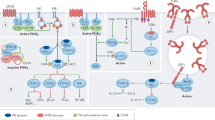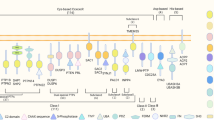Abstract
Phosphoinositide 3-kinases (PI3K) have long been considered promising drug targets for the treatment of inflammatory and autoimmune disorders as well as cancer and cardiovascular diseases. But the lack of specificity, isoform selectivity and poor biopharmaceutical profile of PI3K inhibitors have so far hampered rigorous disease-relevant target validation. Here we describe the identification and development of specific, selective and orally active small-molecule inhibitors of PI3Kγ (encoded by Pik3cg). We show that Pik3cg−/− mice are largely protected in mouse models of rheumatoid arthritis; this protection correlates with defective neutrophil migration, further validating PI3Kγ as a therapeutic target. We also describe that oral treatment with a PI3Kγ inhibitor suppresses the progression of joint inflammation and damage in two distinct mouse models of rheumatoid arthritis, reproducing the protective effects shown by Pik3cg−/− mice. Our results identify selective PI3Kγ inhibitors as potential therapeutic molecules for the treatment of chronic inflammatory disorders such as rheumatoid arthritis.
This is a preview of subscription content, access via your institution
Access options
Subscribe to this journal
Receive 12 print issues and online access
$209.00 per year
only $17.42 per issue
Buy this article
- Purchase on Springer Link
- Instant access to full article PDF
Prices may be subject to local taxes which are calculated during checkout





Similar content being viewed by others
References
Vanhaesebroeck, B. et al. Synthesis and function of 3-phosphorylated inositol lipids. Annu. Rev. Biochem. 70, 535–602 (2001).
Bi, L., Okabe, I., Bernard, D.J., Wynshaw-Boris, A. & Nussbaum, R.L. Proliferative defect and embryonic lethality in mice homozygous for a deletion in the p110alpha subunit of phosphoinositide 3-kinase. J. Biol. Chem. 274, 10963–10968 (1999).
Bi, L., Okabe, I., Bernard, D.J. & Nussbaum, R.L. Early embryonic lethality in mice deficient in the p110beta catalytic subunit of PI 3-kinase. Mamm. Genome 13, 169–172 (2002).
Okkenhaug, K. et al. Impaired B and T cell antigen receptor signaling in p110delta PI 3-kinase mutant mice. Science 297, 1031–1034 (2002).
Clayton, E. et al. A crucial role for the p110delta subunit of phosphatidylinositol 3-kinase in B cell development and activation. J. Exp. Med. 196, 753–763 (2002).
Jou, S.T. et al. Essential, nonredundant role for the phosphoinositide 3-kinase p110delta in signaling by the B-cell receptor complex. Mol. Cell. Biol. 22, 8580–8591 (2002).
Ali, K. et al. Essential role for the p110delta phosphoinositide 3-kinase in the allergic response. Nature 431, 1007–1011 (2004).
Sasaki, T. et al. Function of PI3Kgamma in thymocyte development, T cell activation, and neutrophil migration. Science 287, 1040–1046 (2000).
Hirsch, E. et al. Central role for G protein-coupled phosphoinositide 3-kinase gamma in inflammation. Science 287, 1049–1053 (2000).
Li, Z. et al. Roles of PLC-beta2 and -beta3 and PI3Kgamma in chemoattractant-mediated signal transduction. Science 287, 1046–1049 (2000).
Del Prete, A. et al. Defective dendritic cell migration and activation of adaptive immunity in PI3Kgamma-deficient mice. EMBO J. 23, 3505–3515 (2004).
Laffargue, M. et al. Phosphoinositide 3-kinase gamma is an essential amplifier of mast cell function. Immunity 16, 441–451 (2002).
Smolen, J.S. & Steiner, G. Therapeutic strategies for rheumatoid arthritis. Nat. Rev. Drug Discov. 2, 473–488 (2003).
Trentham, D.E. Collagen arthritis as a relevant model for rheumatoid arthritis. Arthritis Rheum. 25, 911–916 (1982).
Stuart, J.M., Townes, A.S. & Kang, A.H. Collagen autoimmune arthritis. Annu. Rev. Immunol. 2, 199–218 (1984).
Terato, K. et al. Induction of arthritis with monoclonal antibodies to collagen. J. Immunol. 148, 2103–2108 (1992).
Szekanecz, Z., Kim, J. & Koch, A.E. Chemokines and chemokine receptors in rheumatoid arthritis. Semin. Immunol. 15, 15–21 (2003).
Feldmann, M., Brennan, F.M. & Maini, R.N. Role of cytokines in rheumatoid arthritis. Annu. Rev. Immunol. 14, 397–440 (1996).
Edwards, S.W. & Hallett, M.B. Seeing the wood for the trees: the forgotten role of neutrophils in rheumatoid arthritis. Immunol. Today 18, 320–324 (1997).
Benoist, C. & Mathis, D. Mast cells in autoimmune disease. Nature 420, 875–878 (2002).
Lee, D.M. et al. Mast cells: a cellular link between autoantibodies and inflammatory arthritis. Science 297, 1689–1692 (2002).
Chatham, W.W. et al. Degradation of human articular cartilage by neutrophils in synovial fluid. Arthritis Rheum. 36, 51–58 (1993).
Kitsis, E. & Weissmann, G. The role of the neutrophil in rheumatoid arthritis. Clin. Orthop. 265, 63–72 (1991).
Kowanko, I.C., Ferrante, A., Clemente, G., Youssef, P.P. & Smith, M. Tumor necrosis factor priming of peripheral blood neutrophils from rheumatoid arthritis patients. J. Clin. Immunol. 16, 216–221 (1996).
Mohr, W., Pelster, B. & Wessinghage, D. Polymorphonuclear granulocytes in rheumatic tissue destruction. VI. The occurrence of PMNs in menisci of patients with rheumatoid arthritis. Rheumatol. Int. 5, 39–44 (1984).
Wipke, B.T. & Allen, P.M. Essential role of neutrophils in the initiation and progression of a murine model of rheumatoid arthritis. J. Immunol. 167, 1601–1608 (2001).
Nandakumar, K.S., Svensson, L. & Holmdahl, R. Collagen type II-specific monoclonal antibody-induced arthritis in mice: description of the disease and the influence of age, sex, and genes. Am. J. Pathol. 163, 1827–1837 (2003).
Johnson, Z. et al. Chemokine inhibition–why, when, where, which and how? Biochem. Soc. Trans. 32, 366–377 (2004).
Wetzker, R. & Rommel, C. Phosphoinositide 3-kinases as targets for therapeutic intervention. Curr. Pharm. Des. 10, 1915–1922 (2004).
Camps, M. et al. Use of a scintillating solid support coated with an aminoglycoside for identifying and/or quantifying a radiolabeled aminoglycoside binding molecule such as mono- or polyphosphated phosphoinositide in a sample. in WO2002101084 (Applied Research Systems Ars Holding N.V., 2002).
Weiss-Haljiti, C. et al. Involvement of phosphoinositide 3-kinase gamma, Rac, and PAK signaling in chemokine-induced macrophage migration. J. Biol. Chem. 279, 43273–43284 (2004).
Lopez-Ilasaca, M., Crespo, P., Pellici, P.G., Gutkind, J.S. & Wetzker, R. Linkage of G protein-coupled receptors to the MAPK signaling pathway through PI 3-kinase gamma. Science 275, 394–397 (1997).
Henderson, R.B., Hobbs, J.A., Mathies, M. & Hogg, N. Rapid recruitment of inflammatory monocytes is independent of neutrophil migration. Blood 102, 328–335 (2003).
Kerwar, S.S. et al. Type II collagen-induced arthritis. Studies with purified anticollagen immunoglobulin. Arthritis Rheum. 26, 1120–1131 (1983).
Katso, R. et al. Cellular function of phosphoinositide 3-kinases: implications for development, homeostasis, and cancer. Annu. Rev. Cell Dev. Biol. 17, 615–675 (2001).
Carpenter, C.L. & Cantley, L.C. Phosphoinositide kinases. Curr. Opin. Cell Biol. 8, 153–158 (1996).
Firestein, G.S. Evolving concepts of rheumatoid arthritis. Nature 423, 356–361 (2003).
Yoshino, S. & Cleland, L.G. Depletion of alpha/beta T cells by a monoclonal antibody against the alpha/beta T cell receptor suppresses established adjuvant arthritis, but not established collagen-induced arthritis in rats. J. Exp. Med. 175, 907–915 (1992).
Seki, N. et al. Type II collagen-induced murine arthritis. I. Induction and perpetuation of arthritis require synergy between humoral and cell-mediated immunity. J. Immunol. 140, 1477–1484 (1988).
Rueckle, T., Jiang, X., Gaillard, P., Church, D. & Vallotton, T. Azolidinone-vinyl fused-benzene derivatives. in WO2004007491 (Applied Research Systems Ars Holding N.V., 2004).
Collaborative Computational Project Number 4. Acta Crystallogr. D Biol Crystallogr. D50, 760–763 (1994).
Walker, E.H. et al. Structural determinants of phosphoinositide 3-kinase inhibition by wortmannin, LY294002, quercetin, myricetin, and staurosporine. Mol. Cell 6, 909–919 (2000).
Acknowledgements
We thank E. Ammanati, M. Carbonatto and S. Carboni for technical support and P. Gaillard, D. Church, T. Vallotton-Grippi, M. Maio and D. Covini for support in chemistry, A. Proudfoot's team for protein chemistry and C. Retzler and J. Hassa for advice. We are thankful to R. Williams for advice and technical support for crystallization. We further thank B. Vanhaesebroeck, K. Okkenhaug, R. Wetzker and in particular A. Carrera for support, advice and enthusiasm throughout the project, L. Stephens for advice and K. Jeffrey for critical reading of the manuscript. We are grateful to C. Hebert for graphic support, C. Mark for editorial support and P. Cavioli for administrative assistance. We especially thank M. Kosco-Vilbois for encouragement when this project was initiated. We thank S. Arkinstall and T. Wells for support throughout the entire study. This work was supported by European Union Fifth Framework Program QLG1-2001-02171 to E.H., M.P.W. and C.R.
Author information
Authors and Affiliations
Corresponding author
Ethics declarations
Competing interests
The authors declare no competing financial interests.
Supplementary information
Supplementary Fig. 1
Determination of the kinetic parameters of the four different PI3K isoforms. (PDF 43 kb)
Supplementary Fig. 2
Kinase selectivity profile of LY294002, AS-604850, AS-605240 and AS-605091. (PDF 21 kb)
Supplementary Fig. 3
Determination of in vitro and in vivo pharmacological parameters of AS-605240. (PDF 20 kb)
Supplementary Table 1
Enzymatic parameters for Class I PI3Kγ isoforms, obtained from the experiments shown in Supplementary Fig. 1. (PDF 13 kb)
Supplementary Table 2
Summary of the crystallographic information obtained from PI3Kγ crystals soaked with AS-604850 and AS-605240. (PDF 19 kb)
Supplementary Table 3
Selectivity profile of PI3K inhibitors for Class I PI3K isoforms. (PDF 12 kb)
Rights and permissions
About this article
Cite this article
Camps, M., Rückle, T., Ji, H. et al. Blockade of PI3Kγ suppresses joint inflammation and damage in mouse models of rheumatoid arthritis. Nat Med 11, 936–943 (2005). https://doi.org/10.1038/nm1284
Received:
Accepted:
Published:
Issue Date:
DOI: https://doi.org/10.1038/nm1284
This article is cited by
-
Tau deficiency inhibits classically activated macrophage polarization and protects against collagen-induced arthritis in mice
Arthritis Research & Therapy (2023)
-
Exploration of the mechanism by which Huangqi Guizhi Wuwu decoction inhibits Lps-induced inflammation by regulating macrophage polarization based on network pharmacology
BMC Complementary Medicine and Therapies (2023)
-
Exosomal microRNA-140-3p from human umbilical cord mesenchymal stem cells attenuates joint injury of rats with rheumatoid arthritis by silencing SGK1
Molecular Medicine (2022)
-
The role of PI3Kγ in the immune system: new insights and translational implications
Nature Reviews Immunology (2022)
-
A novel cytokine consisting of the p40 and EBI3 subunits suppresses experimental autoimmune arthritis via reciprocal regulation of Th17 and Treg cells
Cellular & Molecular Immunology (2022)



